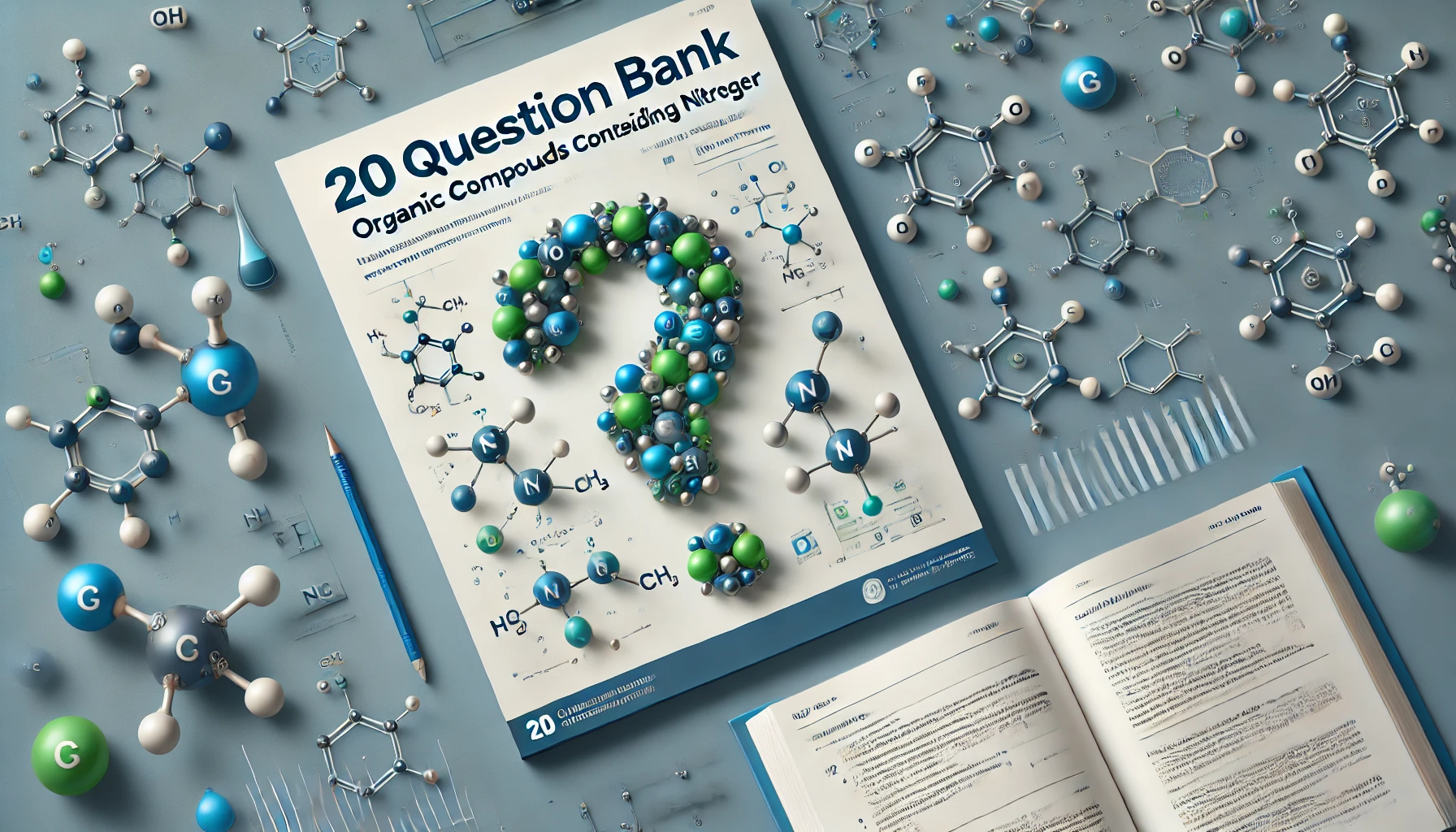Test Your Knowledge with Challenging Questions on Organic Compounds Containing Nitrogen
This curated set of 20 questions focuses on organic compounds containing nitrogen, offering a comprehensive review for students and professionals alike. The question bank covers key topics such as amines, amides, nitriles, and nitrogen-containing heterocycles. Each question is designed to test understanding of fundamental concepts, reaction mechanisms, and the role of nitrogen in various organic compounds. Ideal for exam preparation or self-assessment, this resource helps reinforce critical thinking and problem-solving skills in organic chemistry, especially in the context of nitrogen’s reactivity and applications.
Table of Contents
1. What are the general methods of preparation for organic compounds containing nitrogen?
Answer: Organic compounds containing nitrogen can be prepared through various methods such as:
- Direct amination of hydrocarbons.
- Reduction of nitro compounds.
- Gabriel phthalimide synthesis for primary amines.
- Hoffmann degradation of amides.
- Reduction of nitriles and oximes.
2. Describe the properties of amines.
Answer: Amines are characterized by their basicity, nucleophilicity, and the presence of a lone pair of electrons on the nitrogen atom. They are generally polar, can form hydrogen bonds, and have boiling points higher than alkanes but lower than alcohols of similar molecular weight.
3. Explain the reactions of amines.
Answer: Amines undergo various reactions such as:
- Alkylation and acylation.
- Formation of amides.
- Reaction with nitrous acid (different reactions for primary, secondary, and tertiary amines).
- Electrophilic aromatic substitution in arylamines.
4. What are the uses of amines?
Answer: Amines are used in:
- Synthesis of pharmaceuticals.
- Production of dyes.
- Manufacturing of agrochemicals.
- Preparation of polymers and resins.
- As corrosion inhibitors.
5. What is the nomenclature of amines?
Answer: Amines are named by replacing the suffix ‘-e’ of the parent hydrocarbon with ‘-amine’. For example, methane becomes methanamine. Substituted amines are named by identifying the substituents and adding them as prefixes. In complex amines, the NH₂ group is named as an amino substituent.
6. How are amines classified?
Answer: Amines are classified based on the number of alkyl or aryl groups attached to the nitrogen atom:
- Primary amines (R-NH₂)
- Secondary amines (R₂NH)
- Tertiary amines (R₃N)
7. Describe the structure of primary, secondary, and tertiary amines.
Answer:
- Primary amines have one alkyl or aryl group attached to the nitrogen.
- Secondary amines have two alkyl or aryl groups attached.
- Tertiary amines have three alkyl or aryl groups attached.
8. What determines the basic character of amines?
Answer: The basic character of amines is determined by the availability of the lone pair of electrons on the nitrogen for donation. Electron-donating groups increase the basicity, while electron-withdrawing groups decrease it.
9. How do you identify primary amines?
Answer: Primary amines can be identified by:
- Reaction with nitrous acid to form nitrogen gas and an alcohol.
- Formation of acetamides when reacted with acetic anhydride.
10. How do you identify secondary amines?
Answer: Secondary amines react with nitrous acid to form a yellow oily nitrosamine. They do not form nitrogen gas like primary amines.
11. How do you identify tertiary amines?
Answer: Tertiary amines do not react with nitrous acid under mild conditions but can form quaternary ammonium salts when reacted with alkyl halides.
12. Compare the basic character of primary, secondary, and tertiary amines.
Answer: The basicity order is generally secondary amines > primary amines > tertiary amines in the gas phase due to electron-releasing alkyl groups. However, in aqueous solution, the order can vary due to solvation effects.
13. What are diazonium salts?
Answer: Diazonium salts are organic compounds with the general formula ArN₂⁺X⁻, where Ar is an aryl group and X is a halide or other anion.
14. How are diazonium salts prepared?
Answer: Diazonium salts are prepared by diazotization, which involves reacting a primary aromatic amine with nitrous acid (generated in situ from sodium nitrite and a mineral acid) at low temperatures.
15. Describe the importance of diazonium salts in synthetic organic chemistry.
Answer: Diazonium salts are important intermediates in organic synthesis, particularly for: – The Sandmeyer reaction to introduce halogens into aromatic rings. – The Gattermann reaction to form aryl chlorides and bromides. – Coupling reactions to form azo dyes. – Substitution reactions to form phenols, nitriles, and other functional groups.
16. What is the Sandmeyer reaction?
Answer: The Sandmeyer reaction is a method of replacing the diazonium group in an aromatic diazonium salt with a halide using copper(I) halides as catalysts.
17. What is the Gattermann reaction?
Answer: The Gattermann reaction involves the replacement of the diazonium group with a halogen (chlorine or bromine) using halogen acids in the presence of copper powder.
18. Explain the coupling reactions of diazonium salts.
Answer: Coupling reactions involve the reaction of diazonium salts with phenols or aromatic amines to form azo compounds, which are important as dyes.
19. What are azo dyes and their significance?
Answer: Azo dyes are colored compounds formed by the coupling of diazonium salts with aromatic compounds. They are widely used in the textile industry for dyeing fabrics due to their vibrant colors and stability.
20. Describe the role of nitrous acid in the reactions of amines.
Answer: Nitrous acid reacts differently with primary, secondary, and tertiary amines: – With primary amines, it forms diazonium salts. – With secondary amines, it forms nitrosamines. – With tertiary amines, it can lead to complex reactions or no reaction under mild conditions.
This question bank covers the fundamental concepts related to organic compounds containing nitrogen, including methods of preparation, properties, reactions, and applications of amines and diazonium salts.
